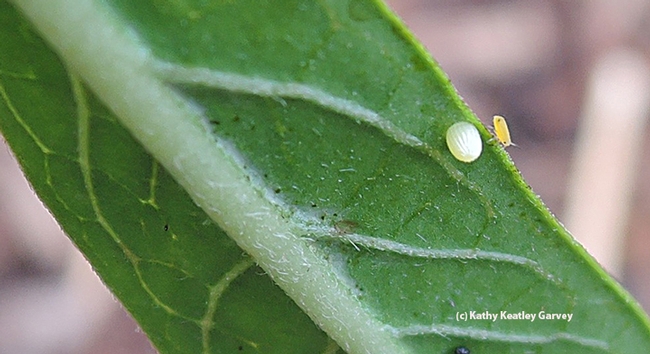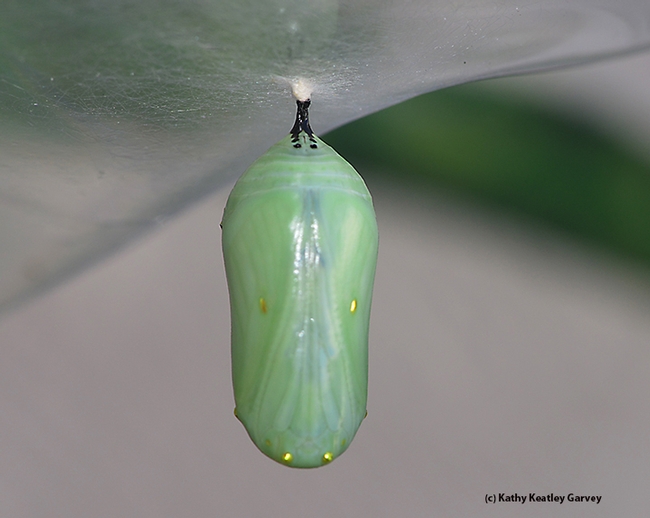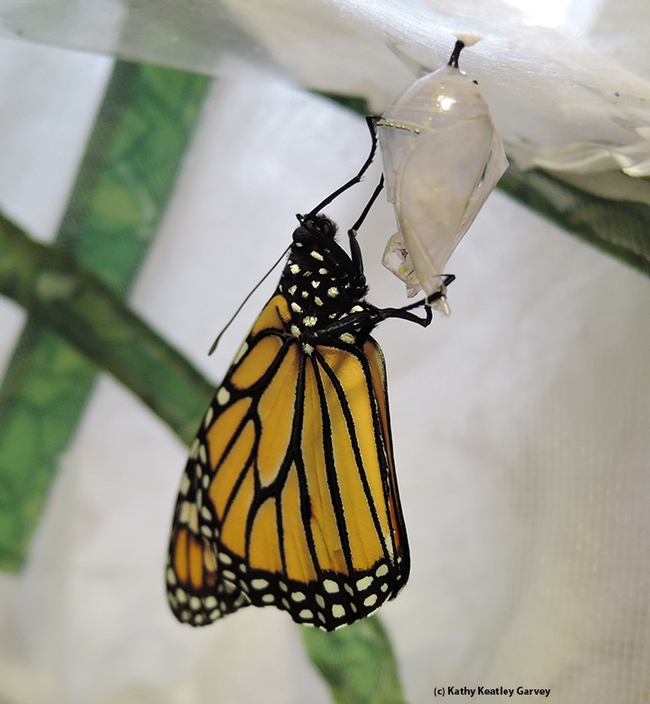Have you ever seen a monarch butterfly (Danaus plexippus) lay an egg on her host plant, the milkweed?
Have you ever seen a close-up of the egg? The larva or caterpillar? The chrysalis? The eclosure (when the adult emerges from the chrysalis)?
It's a fascinating sight.
Not all eggs will make it. Predators, such as lady beetles and their larvae, gobble up monarch eggs along with those tasty aphids. Birds, such as scrub jays, swoop down and make off with an occasional caterpillar. Then when the fifth instar finally starts to form a chrysalis, there's always the question of whether it will do so. Some are deformed and turn out to be half chrysalis and half caterpillar.
But once you've watched a complete metamorphosis, you'll never underappreciate monarchs again. In fact, you'll probably start rearing them every year. We just reared our first two this month.
It's easy to see why teachers and their students get so excited. We remember writing about Sal (Sally) Levinson's newly published book, Butterfly Papercrafts, which contains 21 indoor projects for outdoor learning. Levinson, who studied entomology at the graduate level at UC Riverside and UC Berkeley, wants to inspire youngsters to learn about our amazing world of butterflies through art and a little science.
It's intended for youngsters ages 5-12, but really, it's also a beginner's book for all ages and a teacher's treasure. And it's priced right--under $10 ($9.99). Readers can learn about the life cycle, from egg to caterpillar to chrysalis to adult; and craft a butterfly paper airplane, a caterpillar flip book, and a monarch finger puppet.
Meanwhile, North America's monarchs are heading for their overwintering sites in two main areas: the mountains of central Mexico, and choice spots along the California coast, including Pacific Grove and Santa Cruz.
"The annual migration of North America's monarch butterfly is a unique and amazing phenomenon," according to the U.S. Department of Agriculture's Forest Service website. "The monarch is the only butterfly known to make a two-way migration as birds do. Unlike other butterflies that can overwinter as larvae, pupae, or even as adults in some species, monarchs cannot survive the cold winters of northern climates. Using environmental cues, the monarchs know when it is time to travel south for the winter. Monarchs use a combination of air currents and thermals to travel long distances. Some fly as far as 3,000 miles to reach their winter home."
You'll see a migration map on the Forest Service website. You can check out the monarch sightings on this map and report the ones you see.
Go, monarchs!
Attached Images:

A monarch laying an egg on her host plant, milkweed. (Photo by Kathy Keatley Garvey)

Close-up of a cream-colored monarch egg. Note the oleander or milkweed aphid next to it. (Photo by Kathy Keatley Garvey)

A very tiny caterpillar but it's big enough to start eating holes in the leaves. (Photo by Kathy Keatley Garvey)

A fifth-instar monarch caterpillar. (Photo by Kathy Keatley Garvey)

The jade green chrysalid. (Photo by Kathy Keatley Garvey)

Voila! A monarch butterfly has just eclosed. (Photo by Kathy Keatley Garvey)

A monarch sipping nectar from a Mexican sunflower (Tithonia). (Photo by Kathy Keatley Garvey)